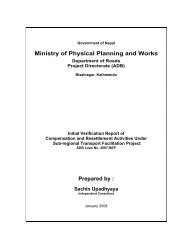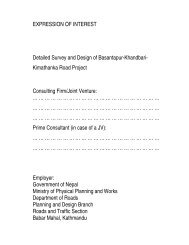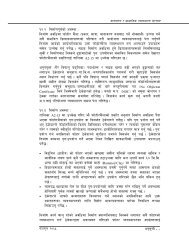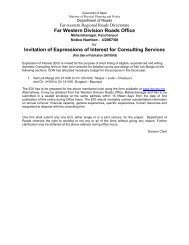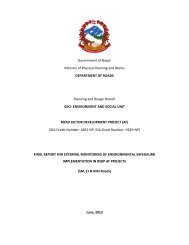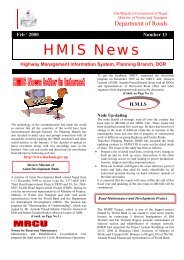Environmental & Social Management Framework - About ...
Environmental & Social Management Framework - About ...
Environmental & Social Management Framework - About ...
You also want an ePaper? Increase the reach of your titles
YUMPU automatically turns print PDFs into web optimized ePapers that Google loves.
<strong>Environmental</strong> and <strong>Social</strong> <strong>Management</strong> <strong>Framework</strong>Slope stability(8) Preparation of the <strong>Environmental</strong>/<strong>Social</strong> <strong>Management</strong> Action Plan (EMAP)An <strong>Environmental</strong> <strong>Management</strong> Action Plan (EMAP) 2 consists of the descriptiveset of mitigation, monitoring, and institutional measures to be taken duringimplementation and operation to eliminate adverse environmental impacts, offsetthem, or reduce them to acceptable levels. The guiding principles and technicalsolution aspects, tailored for Nepalese conditions, are reflected in the<strong>Environmental</strong> Code of Practice outlined in Ch. 2.3. and Annex 2 of this ESMF.Any construction will not begin before an EMAP is prepared and approved by theconcerned agency.The EMAP shall also clearly identify the roles and responsibilities of institutionsand involved (contractual) parties to carry out the management activities, anddefine the location of verification of the prescribed measures. It is recommendedthat the implementation tables being prepared for the forthcoming sub-projectsunder the SRN Program utilize a standard tabulated format in presenting thearrangements for implementing the mitigation measures, as shown in Table. 2.8:Table 2.8: Mitigation Implementation – Description of ArrangementsMitigationImplementation ResponsibilityActivity Project Design Contract Bill of Quantity MonitoringContractor must Identify stabilizationcomply with clauses area.Specify bio-engineering pertaining to Provide list ofand relevant techniques. safeguard and species to formitigation clauses in plantingthe contract. requirementsSpoil disposalWatermanagementLand usePlants andwildlifeQuarries andborrow pitsStone crushingand asphaltplantsIdentify mass balancetechniques.Safe tipping areasidentified and enforced.Design spoil traps.Design safe dischargedrainage and techniques(check dam) to naturalwater course.Explore use of marginalland.Check impacts arelimited to compensatedtrees and products.Consider constructionaffecting forests andproductive crop lands.Design bunds to screennoise and dust.Design re-gradingslopes.Use bio-engineeringtechniques forrehabilitation.Specify noise andemission requirements;Specify siting criteriaDoDoDo -Do, especiallyexclude hunting andcollecting activitiesDoDoQuantify disposaland extractionvolume.Physical works forsafe dischargedrainage listed.-Quantify restorationcosts and presenttechnicalspecifications.Amount to beincluded incontractor's ownexpense.Disallow non-permissiblespeciesAdequacy, quality ofvegetation.Survival rate of plants.Presence of scouring,erosion, damage to property,water supply disruption.Complaints from localpeopleEvidence of fresh surfaceerosion, presence of gullies,increase in water turbidity,loss of agriculture forestland.Slope condition.Public complaints.Quantify actual land usepattern for construction andother activities.Public complaints.Check habitats re-createdon marginal roadside land.Check for water ponding,formation of gullies, waterturbidity.Check unauthorizedquarrying activities.Control siting and emission.Dust control equipmentbeing utilized.Public complaints.2 Sometimes referred as to <strong>Environmental</strong> <strong>Management</strong> Plan (EMP)April 2007 Chapter 2-23


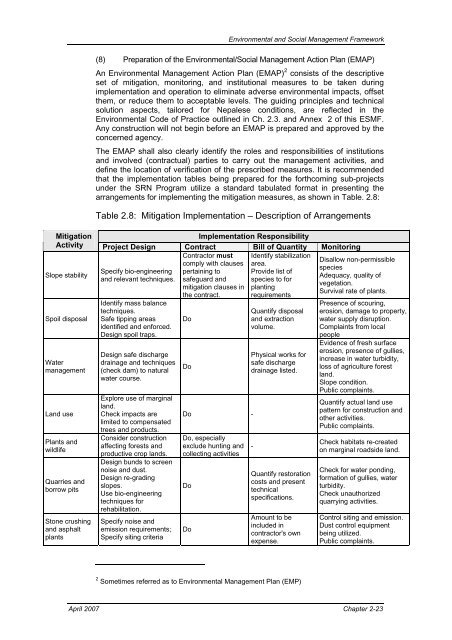
![j:6 ]zg cfof ]hgf](https://img.yumpu.com/51286794/1/190x245/j6-zg-cfof-hgf.jpg?quality=85)

![x'nfsL /fhdfu { cfof ]hgf](https://img.yumpu.com/50581959/1/190x245/xnfsl-fhdfu-cfof-hgf.jpg?quality=85)
